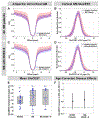Glutamate-sensitive imaging and evaluation of cognitive impairment in multiple sclerosis
- PMID: 30230400
- PMCID: PMC6424643
- DOI: 10.1177/1352458518799583
Glutamate-sensitive imaging and evaluation of cognitive impairment in multiple sclerosis
Abstract
Background: Cognitive impairment (CI) profoundly impacts quality of life for patients with multiple sclerosis (MS). Dysfunctional regulation of glutamate in gray matter (GM) has been implicated in the pathogenesis of MS by post-mortem pathological studies and in CI by in vivo magnetic resonance spectroscopy, yet GM pathology is subtle and difficult to detect using conventional T1- and T2-weighted magnetic resonance imaging (MRI). There is a need for high-resolution, clinically accessible imaging techniques that probe molecular changes in GM.
Objective: To study cortical GM pathology related to CI in MS using glutamate-sensitive chemical exchange saturation transfer (GluCEST) MRI at 7.0 Tesla (7T).
Methods: A total of 20 patients with relapsing-remitting MS and 20 healthy controls underwent cognitive testing, anatomical imaging, and GluCEST imaging. Glutamate-sensitive image contrast was quantified for cortical GM, compared between cohorts, and correlated with clinical measures of CI.
Results and conclusion: Glutamate-sensitive contrast was significantly increased in the prefrontal cortex of MS patients with accumulated disability (p < 0.05). In addition, glutamate-sensitive contrast in the prefrontal cortex was significantly correlated with symbol digit modality test (rS = -0.814) and choice reaction time (rS = 0.772) scores in patients (p < 0.05), suggesting that GluCEST MRI may have utility as a marker for GM pathology and CI.
Keywords: Multiple sclerosis; cognitive dysfunction; glutamate; gray matter; magnetic resonance imaging; prefrontal cortex.
Conflict of interest statement
Conflict of interest
The authors declare that there is no conflict of interest.
Figures




References
-
- Schultheis MT, Garay E and DeLuca J. The influence of cognitive impairment on driving performance in multiple sclerosis. Neurology 2001; 56: 1089–1094. - PubMed
Publication types
MeSH terms
Substances
Grants and funding
LinkOut - more resources
Full Text Sources
Other Literature Sources
Medical

